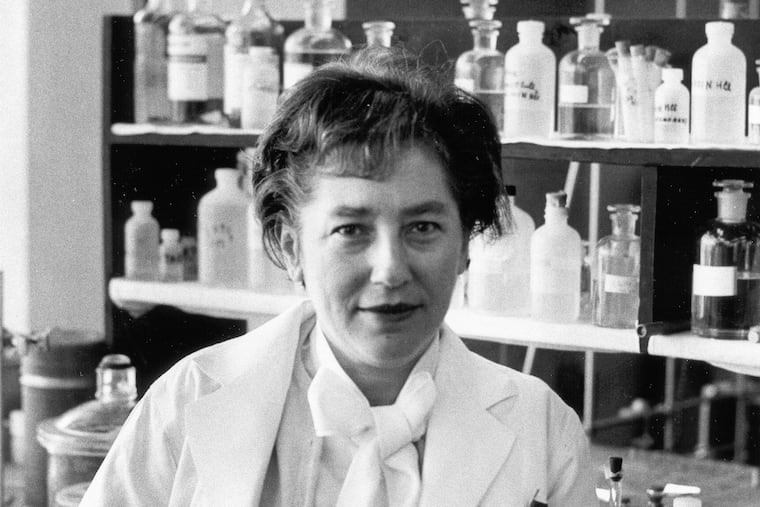Nine women who changed science are featured in a new Philly exhibit
The exhibit, at the American Philosophical Society, runs through the end of the year.

Mildred Cohn was such a star in school that she enrolled in college at age 15, only to have a professor tell her it was “unladylike” for women to go into her chosen field, chemistry.
She did it anyway — going on to become the first woman to earn a Ph.D. in chemistry from Columbia University, in 1937.
Yet she continued to encounter discrimination throughout the 1940s and 1950s when looking for work. Industry positions often specified that only “male, Christian” applicants were welcome. Cohn, who was Jewish, instead worked in lower-ranking academic jobs that were beneath her qualifications.
In 1960, Cohn finally landed a tenure-track position at the University of Pennsylvania’s medical school, where she won renown for deciphering the structures of chemical compounds. But along with the science, she devoted her career to a personal mission: working to make sure others would not face the same obstacles she did.
Her story, and those of eight other female pioneers in the sciences, are featured in “Pursuit & Persistence: 300 Years of Women in Science,” a new exhibit at the American Philosophical Society in Philadelphia.
The exhibit features dozens of historical documents and artifacts from the society’s collection, most of them never before on public display. Among them is a strongly worded memo from Cohn to her white male colleagues at Penn in the 1970s, advising her peers on how to interact with women and people of color, who were joining the faculty in increasing numbers.
“These new colleagues are sensitive, feeling, perceptive people, not curiosities to be examined, paraded around, ogled, and denigrated,” she warned.
The exhibit, which runs through the end of the year, is housed in the red-brick building just to the left of Independence Hall — one of several buildings owned by the learned society that Ben Franklin founded in 1743.
The letters, photos, and other items illustrate how female scientists have encountered similar obstacles across the centuries. They were often discouraged from pursuing their passions and when they found employment, worked for lower pay and lesser recognition.
Some, such as 18th-century French mathematician and physicist Émilie du Châtelet, had financial resources that helped them to overcome these hurdles. The daughter of aristocrats and a longtime companion of French philosopher Voltaire, she won acclaim for her translation of Isaac Newton’s writings (a sample of which is in the exhibit) and her own research on the nature of fire.
Others, such as Cohn, forged a path by working with other women. The exhibit includes a diagram of social networks established by her and other female scientists, with dozens of lines drawn between each pair of women who corresponded about mentorship, research collaboration, and other science topics. (An interactive version of that diagram is available on the museum’s website, created by researchers who spent years sifting through archives.)
In 1970, Cohn also chaired a committee on the status of women at Penn. Excerpts from the group’s findings are included in the exhibit: Women accounted for just 2.5% of full professors, 7% of associate professors, and 12.7% of assistant professors at the time.
In the fall of 2022, women accounted for 38.6% of faculty with tenure or on a tenure track, according to a table on the school website.
In addition to the large displays about Cohn and the eight other featured scientists, the exhibit includes smaller selections about several others — among them Beatrice Mintz, who worked for six decades at Fox Chase Cancer Center before her death in 2022, at age 100. Visitors can see images of cells she worked with at the research center in Northeast Philadelphia, along with her white lab coat, still adorned with her I.D. badge and an assortment of pens in the front pocket.
The exhibit also includes a small display about the first computer programmers — six women who operated ENIAC, a room-sized, electronic contraption unveiled in 1946 at the University of Pennsylvania. Museumgoers can see a facsimile of a blueprint of ENIAC, showing some of the switches and connections that the six programmers used.
In between the historical items, the exhibition also includes a series of sculptures by artist Rebecca Kamen, who drew her inspiration from the scientists’ accomplishments.
Even when they reached the pinnacle of achievement, the women never forgot the obstacles they had to overcome. For example, the exhibit includes the handwritten draft of a speech by geneticist Barbara McClintock, in which she described how her work was not taken seriously by her peers for much of the 20th century.
Her findings would prove to be correct, but because they ran counter to the prevailing thinking at the time, she was rarely invited to speak at conferences and was treated as an “outcast,” she wrote.
McClintock wrote those remarks on a piece of stationery from the Grand Hotel in Stockholm, in 1983. She was in Sweden to receive the Nobel Prize in medicine.